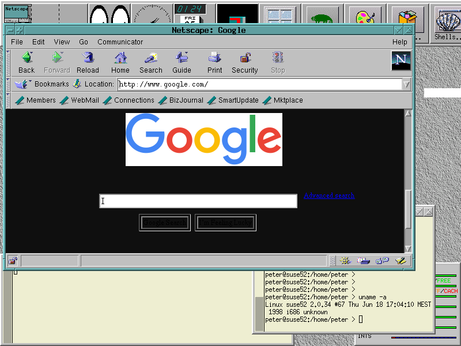Felix Palmen 📯 · @zirias
36 followers · 153 posts · Server techhub.social@thindil @thomasadam How exactly would that work? I mean, I *did* use #fvwm2 "inside" #KDE a long time ago, but scripted the ~/.xsession for that manually ...
So, if there's some .desktop file for #fvwm3 with "Type=XSession", would e.g. sddm offer me a session "Plasma+FVWM3" or something like that when plasma is installed as well? 🤔
Alex · @maplin
22 followers · 103 posts · Server hachyderm.ioRandom question on the subject of #Linux window managers.
Is anyone out there still using #FVWM? And if so, how are you integrating "modern" needs (e.g. network config, battery monitoring)?
I have really fond memories of using #FVWM2 back in the day, before moving on to #Openbox.
Marina · @diese_meerjungfrau
271 followers · 4 posts · Server lsbt.meIn meiner Vorstellung schrieb ich ja, dass ich Linux nutze. Dabei habe ich eine gewisse Vorliebe für Konsolen-Programme wie z. B. #mutt. Oder einem altehrwürdigen Window Manager wie #fvwm2. Ich mag es, Programme via Textdatei zu konfigurieren. Derzeit ist mutt das Bastelobjekt meines Herzens – ein bewährtes Mail-Programm, das sich per Tastenkombinationen bedienen lässt.
Linux-PCs habe ich übrigens zwei: einen stromsparenden lüfterlosen Mini-PC für einfache Aufgaben und einen großen Desktop-PC, wenn ich mehr Rechenleistung benötige. Beide laufen unter #Kubuntu Linux. Der Mini-PC übernimmt auch ein paar Server-Aufgaben: ein Plex Media Server, ein dlna-Multimedia-Server, ein Calibre-EBook-Server, ein LanguageTool-Server.
jack · @jack
194 followers · 4494 posts · Server mastodon.sdf.orgChris Siebenmann · @cks
1002 followers · 1390 posts · Server mastodon.socialI idly attempted to move to #fvwm3 from my current #fvwm2 setup (with a somewhat old fvwm2 version), using the same configuration file, but things didn't go. All my colour settings seemed to drop out, among other visual oddities. Oh well, something for the future.
(My current setup works fine so my energy and motivation for switching is not high. I tried it now because of the libX11 issues; if it needs fvwm fixes, they'll likely only be made to fvwm3.)
Chris Siebenmann · @cks
993 followers · 1387 posts · Server mastodon.socialHeads up #fvwm people: it appears that libX11 1.8.x and fvwm may not get along very well (and in Fedora 37, the combination appears to make the X server unhappy too). libX11 1.8 apparently has a number of internal changes to be more 'correct' (in accordance with API documentation) that may make clients unhappy, cf https://gitlab.freedesktop.org/xorg/lib/libx11/-/merge_requests/150
(found by @leah when I hit my libX11 1.8 problems in Fedora 37. I'm on #fvwm2 but maybe this applies to #fvwm3 too.)
parv · @parvXm
66 followers · 2214 posts · Server mastodon.social@benjaminhollon @RL_Dane When I was using #FVWM2 (on FreeBSD) nearly all the time, I was navigating around the windows, pages & clicking on buttons, etc via the keyboard.
Thomas Adam · @thomasadam
71 followers · 88 posts · Server bsd.networkfor #fvwm1 (and for a time, #fvwm2), the man page used to have a BUGS section which listed the following:
As of fvwm 0.99 there were exactly 39.342 unidentified bugs. Identified bugs have mostly been fixed, though. Since then 9.34 bugs have been fixed.
Assuming that there are at least 10 unidentified bugs for every identified one, that leaves us with 39.342 - 9.32 + 10 * 9.34 = 123.402 unidentified bugs. If we follow this to its logical conclusion we will have an infinite number of unidentified bugs before the number of bugs can start to diminish, at which point the program will be bug-free.
Since this is a computer program infinity = 3.4028e+38 if you don't insist on double-precision. At the current rate of bug discovery we should expect to achieve this point in 3.37e+27 years
I guess I better plan on passing this thing on to my children....
The "I" here refers to Robert Nation, the original creator of #fvwm and #rxvt.
As it happens, I've not been able to reduce the number of bugs in #fvwm3 either, and I've no grandchildren...
#fvwm #trivia #fvwm1 #fvwm2 #rxvt #fvwm3
Peter Howkins · @flibble
22 followers · 4 posts · Server digipres.clubVisiting my family, I found the CDROM of the first #Linux I ever installed, it was #Suse Linux 5.2 free on the cover of #PCPro. With a little help from #PCem I got it going again, 22 years later, it's still pretty usable :-o #fvwm2 #Netscape #xf86confighell
#xf86confighell #netscape #fvwm2 #PCem #PCPro #suse #linux
Diese Meerjungfrau · @diese_meerjungfrau
167 followers · 365 posts · Server mastodon.lol#fvwm2 war in den 90ern mein Standard-Desktop unter #Linux. Nach fvwm2 kam #KDE, und dabei bin ich bis heute geblieben. Aber ab und an ist es ganz witzig, zu den Anfängen zurückzukehren (inklusive der #XClock und den #XEyes). Dazu zählen dann auch Programme wie #mutt (E-Mails), #slrn (Newsgroups), #ircII (Internet Relay Chat, der Vorgänger von Mastodon, wenn man so will), #Seamonkey (um etwas #Netscape zu spielen).
#fvwm2 #linux #kde #xclock #xeyes #mutt #slrn #ircii #seamonkey #netscape
Diese Meerjungfrau · @diese_meerjungfrau
167 followers · 365 posts · Server mastodon.lolDiese Meerjungfrau · @diese_meerjungfrau
167 followers · 365 posts · Server mastodon.lolNico -telmich- Schottelius · @nico
210 followers · 265 posts · Server ipv6.social@macsnider Thanks! "Make it sticky"! Somewhat reminds me of the sticky posts app that I used under #fvwm2 - what was its name again?
Jarek Rozanski 📈 · @jrozanski
97 followers · 198 posts · Server mastodon.online

